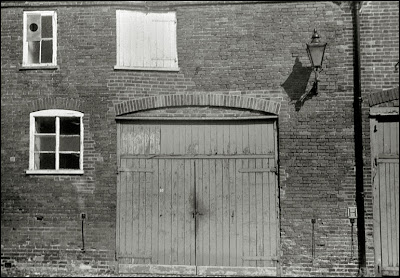
Voigtländer have a long history producing both cameras and lenses. The company were founded in 1756 manufacturing optics and in the 1840's started making Daguerrotype cameras, so they were making cameras at the very start of the photographic industry.
The Bessa 'folding' camera was produced between 1931-49 and took 120 film, giving a negative size of either 6"x9" or with an insert 6"x4.5" there are later Bessa Models, Bessa 1 & 2 I have a review of the Bessa 1 here: Photo Utopia Bessa 1
These cameras also came with different lenses, this one has the cheapest 'Voigtar' 105mm F6.3 the better lenses were the Skopar and colour Skopar.
The framing is done by either a simple folding metal frame (seen on the right in the above photo) or by a small window from waist hight just like the Kodak Brownie.
Focusing is done with a scale, portrait, groups and landscape each marked with a red dot and also distances marked in feet.
The shutter has a very basic range of speeds 1/25 1/50 and 1/125 plus B & T. This was OK in 1930 but in these days of blisteringly fast film of up-to 400 ISO slightly restrictive.
I believe that the models fitted with the Skopar had a better shutter range.
The aperture values are F6.3- F22 which obviously helps with the slow shutter in bright light.

Above is the frame counter window, which is a simple clear red plastic the second window is for the smaller 6x4.5 size.
The film is advanced by turning a metal 'key' and there is no frame locking or winding stop, so you'll have to be careful not to double expose.

In this view we see the back open showing the spool retainer, which is quite neat making the camera pretty easy to load.

The above view is of the camera folded showing on the left the wind on 'key' and at the top right the fold down shutter release.
This type of camera can be found for very little money in thrift shops and jumble sales, and considering how well made they are (it will outlive me I'm sure) they represent a nice project.
They certainly make you slow down and think; wind on- shutter-aperture-focus and are actually great fun to use especially if you have the facility to develop your own negatives.
 Above is an image taken from a roll of Fortepan 100 (formal test of that film soon) and as you can see the result is pretty acceptable considering the age of the camera and un-coated lens, certainly the 6x9 neg size helps as does the fact it was shot at F11.
Above is an image taken from a roll of Fortepan 100 (formal test of that film soon) and as you can see the result is pretty acceptable considering the age of the camera and un-coated lens, certainly the 6x9 neg size helps as does the fact it was shot at F11.In fact i like the feeling of 'antiquity' that the lens gives as its quite low contrast but detailed.
One other caveat I've found is it takes practise to fire the shutter without blur as the top speed is only 1/125 and the fold down shutter release is quite 'clunky' if I was to use this camera regularly I'd use a cable release.
Images and text © Mark Antony Smith
